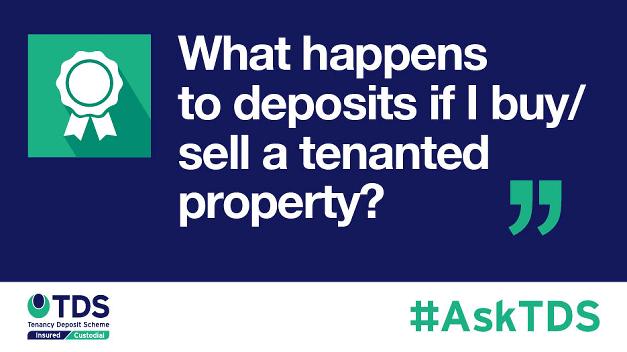#AskTDS: "What happens to deposits if I buy/sell a tenanted property?"

In this week’s #AskTDS, we answer a landlord’s question, “what happens to deposits if I buy/sell a tenanted property?”
There are many reasons why a landlord may decide to sell their property while a tenant is still living in it; but it is important to understand how that affects the tenants’ tenancy deposit for their home. Remember, get it right to avoid any issues which may be costly at a later date.
If a property is sold with the tenants and the tenancy continuing, they are described as ‘tenants in situ’. It’s the responsibility of both the current landlord and new owner to manage the continued protection of the tenancy deposit.
At TDS we offer two choices of tenancy deposit protection; Insured and Custodial. Below we describe what you should do in both schemes.
How does this work under the TDS Insured scheme?
As part of the sale, the seller should agree to pass the deposit to the buyer who will need to register the tenancy deposit for protection. The new landlord should show that the deposit has been registered before it is passed over. The original registration cannot just be transferred between two TDS Insured accounts. Therefore, it is best practice in this case is for the buyer and seller to discuss the tenancy deposit as part of the sales transaction.
The new landlord must also ensure that they inform the tenants where their deposit is protected; and serve the required Prescribed Information. The Prescribed Information is the specific information regarding the protection of their deposit that the Housing Act requires landlords and agents to give to tenants, and any relevant person (any person who has paid the deposit on behalf of the tenants), which includes the scheme leaflet.
How does this work under the TDS Custodial scheme?
Under our TDS Custodial scheme, the buyer will need to register an account. This will give them a TDS Custodial membership number. The seller can then log into to their TDS Custodial account and move the registration data to show under the buying landlord’s account.
The Prescribed Information and scheme leaflet can then be re-issued to the tenants.
In both the Insured and Custodial situations, it would also be good practice to formally amend the tenancy agreement with the new owner/landlord’s name as it is a material change. We have already published details on how a landlord could manage a change from a letting agent to manage the deposit themselves.
For more landlord tips please view our landlord FAQ page.
About TDS:
Tenancy Deposit Scheme (TDS) is a government approved scheme for the protection of tenancy deposits; TDS offers both Insured and Custodial protection and also provides fair adjudication for disputes that arise over the tenancy deposits that we protect.
We provide invaluable training in tenancy deposit protection and disputes for agents and landlords through the TDS Academy as well as joining with MOL to provide the Technical Award in Residential Tenancy Deposits.
TDS Insured Scheme: where a TDS member can hold the tenancy deposits as stakeholder during the term of the tenancy.
TDS Custodial Scheme: where TDS hold the deposit for the duration of the tenancy.
TDS Academy: TDS provides property professionals with invaluable training in tenancy deposit protection and tenancy deposit disputes.
TDS can only comment on the process for our scheme, other deposit protection schemes may have a different process/require different steps. Content is correct at the time of writing.
- Tagged:
- agent
- deposit protection
- deposits
- landlord
- lettings